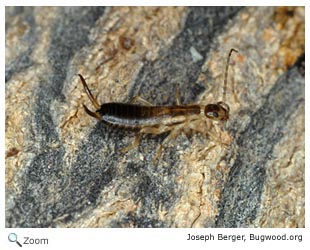Earwigs have long bodies, six legs, and long antennae. Like all insects, they have a segmented body with a head, thorax, and abdomen. Most species have a pair of cerci at the end of their abdomen. Cerci are sensory organs, like antennae, that the earwig uses to feel things. Earwigs may use their cerci for grooming or defense. Some species use their cerci during courtship or to capture prey. In many species, male earwigs have cerci that look like pinchers and females have straight cerci. Most species of earwigs are brown or black. Some species have wings and others don't. In species with wings, the forewings aren't used for flight. They are a hardened shell that closes over and protects the hind wings. Earwigs are nocturnal and are found under rocks, leaf litter, and bark. Most species of earwigs are scavengers and eat decaying plant and animal matter; they may also eat plants and live animals. People used to think that earwigs crawled into people's ears and then burrowed into their brains. This is not true! |
||||||||||


